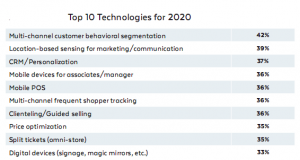Top IT investment priorities for retailers

IT budgets might be growing, but many retailers are reluctant to let go of their legacy systems and struggle to decide where to focus IT investment for future growth. These decisions cannot be delayed any longer because postponing critical technology upgrades and using out-of-date software hinders a retailer’s ability to operate efficiently and optimize profitability.
This is particularly true for retailers that aim to achieve unified retail commerce and so provide a multi-directional, customer-centric experience in stores and online. So what investments should retailers be focused on?
Top Challenges
According to a recent Gartner/RIS News study, the biggest challenges facing retailers are optimizing digital commerce as growth channels, consolidating channel silos, retiring legacy systems, and application integration.

The study also identified the most pressing technology-driven strategies for retailers as expanding unified commerce initiatives, Increasing customer engagement, implementing advanced analytic tools and capabilities, and digital transformation.
Retail Leaders vs. Laggards
The challenges which showed the biggest disparity between retail leaders and laggards were optimizing stores as a growth channel and retiring legacy systems.
Nearly twice as many retail laggards (192%) still identified the optimization of stores as a major obstacle. These retailers should be looking for technologies that help them streamline operations, merchandising and sales management so they can achieve more agility and productivity.
Meanwhile, more than twice (224%) as many retail laggards identified retiring legacy systems as a significant problem to be solved. Many retailers have already invested in an ERP system such as SAP or other management applications, so they are not looking to retire their systems but instead want to makes it easier to integrate the applications and simplify its use.
Integration is one of the strengths of Openbravo Commerce Cloud. Using existing or custom-built connectors, Openbravo makes it easy to integrate with legacy systems as well as add new applications. This way, retailers can preserve their previous investments while gaining the agility, speed and efficiency afforded by a single view of operations.
Where retail leaders are focusing investment
In an age of intense online competition, it is particularly important for retailers to ensure their store operations and supply chain activities are optimized. Customers are impatient and easily frustrated by slow checkouts, out-of-stock items and lengthy delivery times.
So, physical retailers need to ensure their store operations and supply chain activities are integrated, as that not only reduces costs but can also boost sales. Once that is done, they can look at investing in areas such as data analytics to push profitability even further.
The Gartner/RIS News study notes that nearly twice as many retail leaders (184%) identified advanced analytic tools as a top priority, compared to their underperforming counterparts. Leveraging real-time sales data and the use of dynamic demand forecasting and merchandise planning tools allows themmake more informed inventory decisions. These tools should be easy to integrate if you have invested in a modular technology platform such as Openbravo Commerce Cloud.
👉🏼 Want to know more about Openbravo? Take a Product Tour or Contact Us today to find out how Openbravo has helped retailers including Decathlon, Cirque du Soleil, and others to manage their digital transformation successfully.




No Comment